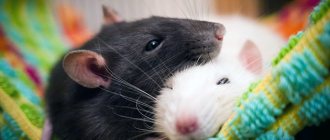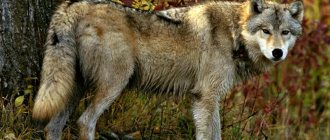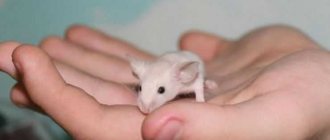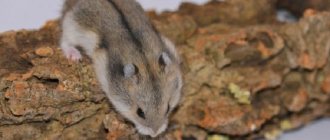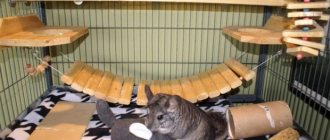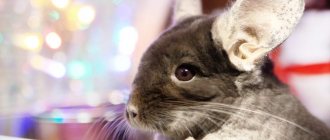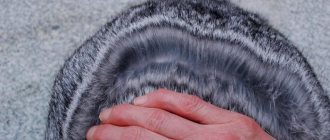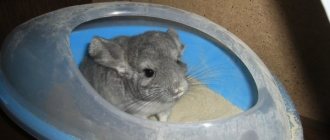- Wild animals
- >>
- Mammals
For many, such an interesting animal as the chinchilla is not at all a rarity; it has long become a common pet. This is no wonder, because these cute fluffy rodents are very attractive and cute. But chinchillas living in the wild are not easy to meet, because there are very few of these animals left, and they live only on one South American continent.
Origin of the species and description
Photo: Chinchilla
It is still unknown who the ancestor of the chinchilla is. Carrying out archaeological excavations in the Cordillera, scientists extracted from the bowels of the earth prehistoric fossils, which in their structure are very similar to chinchillas, only much larger in size. This animal, according to experts, lived forty thousand years ago, so the chinchilla genus is quite ancient. The Incas, many centuries ago, depicted chinchillas on rocks; this painting has survived to this day.
The Incas made various items of clothing from the soft skins of chinchillas, but among the Indians they were far from the first who were so attracted to the fur of rodents. The first who began to wear clothes made from chinchilla skins were the Indians from the Chyncha tribe. It is believed that the chinchilla got its name from them, because the word “chinchilla” itself is consonant with the name of an Indian tribe.
Video: Chinchilla
For the Incas, the value of chinchilla fur was very high; they maintained constant control over their production so as not to harm the animal population. But by the end of the 15th century the situation got out of control, because... The Spaniards who arrived on the mainland began a ruthless hunt for helpless rodents, which led to a rapid decrease in their numbers. The authorities of such South American countries as Chile, Bolivia and Argentina have banned the shooting of animals and their export, and introduced severe punishment for illegal hunting.
The chinchilla is a rodent from the chinchilla family of the same name.
These animals have two varieties:
- short-tailed chinchillas (coastal);
- Chinchillas are large, long-tailed (mountain).
Mountain chinchillas live at high altitudes (more than 2 km), their fur is thicker. This species is distinguished by a hump nose, which is designed for inhaling chilly mountain air. The coastal type of chinchillas is much smaller, but the tail and ears are much longer than those of mountain chinchillas. Officially, the short-tailed chinchilla species is believed to have disappeared completely, although local residents say they have been seen in remote mountainous areas of Argentina and Chile.
It is interesting that the first chinchilla farm was organized by the American Mathias Chapman, who brought the animals to the USA. He began to successfully breed chinchillas in order to sell their valuable fur; many then followed in his footsteps, organizing their own farms.
Appearance and features
Photo: Long-tailed chinchilla
Long-tailed chinchillas are very small, their body grows no more than 38 cm in length. The length of the tail varies from 10 to 18 cm. Long rounded ears reach 6 cm in height. Compared to the body, the head is quite large, the muzzle is round with cute large black eyes, the pupils of which are located vertically. The animal's whiskers (vibrissae) are long, reaching up to 10 cm; they are necessary for orientation in the dark. The weight of an adult rodent is less than a kilogram (700 – 800 g), the female is larger than the male.
The fur coat of the animals is pleasant, fluffy, soft, with the exception of the tail, which is covered with bristly hairs. The color of the fur is usually gray-blue (ashy), the belly is light milky in color. Other colors can be found, but they are rare.
A chinchilla has only 20 teeth, 16 of them are molars (they continue to grow throughout life). Compared to other numerous rodents, chinchillas can be called long-livers; these cute animals live up to 19 years. The chinchilla's paws are small, the animal has 5 fingers on the front limbs, and four on the hind limbs, but they are much longer. Pushing off with their hind legs, chinchillas perform long, deft jumps. The coordination of the animal can be envied; possessing a highly developed cerebellum, the chinchilla skillfully conquers rocky massifs.
An interesting biological feature of the rodent is its skeleton, which is capable of changing its shape (shrinking) if the situation requires it. At the slightest threat, a chinchilla will easily slip into even a tiny crevice. Also, one of the unique features is that the animal does not have sweat glands, so it does not emit any odor at all.
Where does the chinchilla live?
Photo: Animal chinchilla
As already mentioned, the only continent where chinchillas are permanently registered in the wild is South America, or more precisely, the Andes and Cordillera mountain ranges. Animals are distributed from Argentina to Venezuela. The highlands of the Andes are the element of chinchillas, where they climb to heights of up to 3 km.
Little fluffies live in rather harsh, spartan conditions, where cold winds rage almost all year round; in the summer, the daytime temperature does not exceed 23 degrees plus, and winter frosts drop to -35. Rainfall in this area is very rare, so chinchillas avoid water procedures; they are completely contraindicated for them. After all, once wet, the animal will be chilled to the very bones. Rodents prefer to clean their coats by bathing in sand.
Typically, a chinchilla makes its lair in all sorts of small caves, rocky crevices, and between stones. Occasionally they dig holes in order to hide from various predatory ill-wishers. More often, chinchillas occupy abandoned burrows of other animals to live. In the wild, it is possible to meet a chinchilla with your own eyes only in Chile. In other countries there are so few of them that it is not possible to see rodents. And in Chile their population is under threat.
What does a chinchilla eat?
Photo: Chinchilla animal
The chinchilla's preference is plant food, which in the Andes mountains is quite scarce and monotonous.
The main rodent menu includes:
- herbs;
- small bush growth;
- cactus plants (succulents);
- mosses and lichens.
Animals receive moisture from dew and cactus plants, which are very juicy and fleshy. Chinchillas can eat the bark, rhizomes of plants, their berries, and do not disdain various insects. At home, the chinchilla menu is much more varied and tastier. People buy special grain feeds at pet stores. Animals love to eat not only fresh grass, but also various fruits, berries, and vegetables. Chinchillas will not refuse a crust of bread, dried fruits and nuts. Rodents eat hay in large quantities. The diet of chinchillas is very similar to the diet of hares or guinea pigs.
Under natural conditions, chinchillas do not experience any special problems with the intestines and stomach. Although they eat a large amount of green vegetation, some contain a lot of tannins, which help food to be digested normally. Scientists have noticed that in the mountains, next to chinchillas, chinchilla rats live, which make storage rooms with food in their burrows. Chinchillas also constantly use these reserves, eating the food of their prudent and thrifty neighbors.
Diet of the animal
Feeding chinchillas consists of giving concentrated, juicy and roughage, as well as animal feed and vitamins.
Roughage
Rough food includes hay, tree bark, twigs and dried brooms. The best hay option for an animal is legume-grain hay with a large proportion of alfalfa, vetch or clover. However, it is not advisable to feed exclusively bean hay (although this is what the animal eats with great pleasure) - it causes fermentation in the intestines and diarrhea.
Nettle brooms are also useful for animals. And to grind down teeth you need branches of bushes or trees.
Concentrated feed
Concentrates include legumes, various grains, seeds and cereals, bran and even bread. Ready-made feed mixtures for chinchillas also belong to concentrated feeds. A ready-made feed mixture is an excellent option for feeding one or two chinchillas, however, with a large number of animals, it is much more practical and economical to create a grain mixture from various crops.
Of all the grains, the chinchilla eats with particular pleasure:
- Oats,
- Barley,
- Millet,
- Corn,
- Wheat.
- Barley.
It is not recommended to feed to young animals: the grain has a lot of useful components, but is very hard. Adults are recommended to feed crushed barley.
Oats
The most valuable product in the chinchilla diet. It contains a lot of protein and essential fats. You can give the animals both oatmeal and rolled oats. Oatmeal soaked in milk is especially recommended for nursing females. When making a grain mixture, the proportion of oats can reach up to 70% without harm to the animal.
Millet
When choosing millet, it is better to give preference to varieties rich in carotene. It is especially good to simply add to the mixture for feeding young animals and show animals.
Corn
Corn grains are very rich in protein, but this type of protein is less easily absorbed by the chinchilla’s body. Therefore, it is not recommended to feed too many grains. Animals happily eat milk corn, which has a pleasant sweet taste. Dairy corn can even be fed on the cob. The proportion of ripened grain in the feed mixture can reach up to 50%, and for digestibility it is recommended to grind it well.
Wheat
Contains quite a lot of proteins and carbohydrates. It is recommended to grind wheat grains before feeding. Excessive use of wheat in the grain mixture can lead to obesity in the animal.
Grain or grain mixture is fed only in dry form.
It is recommended to change the composition from time to time, diluting the food with dried fruits, legumes or seeds. The animal eats this type of food with great pleasure.
Crumbly porridges cooked without adding oil, salt and other seasonings and in water are also good food. Porridge made from rice, millet, oatmeal, peas and even corn is suitable for feeding.
Another important type of feed is sprouted grain. It is simply necessary for breeding animals during preparation for the breeding season, during mating, during pregnancy and lactation. This grain is very rich in vitamins E and B, which play an important role in the activity of sperm, the formation and development of embryos.
Seeds
The seeds are useful because they contain a lot of fatty acids. Chinchillas love them. Seeds are especially important in the diet of young animals and show chinchillas, since the appearance, shine and thickness of the fur depend on them. The share of seeds in the feed mixture can reach up to 22%.
Legumes
Soybeans, regular beans, lentils and peas are very rich in protein. Legumes can be part of the feed mixture or used as a separate feed. However, it is impossible to feed exclusively legumes - they provoke digestive upset. The share of legumes in the feed should not exceed 10%, and it is better to add them in ground form.
Nuts
All types of nuts are nutritious and highly digestible food. Hazel is most useful for animals - it contains:
- About 70% fat,
- About 20% protein
- About 8% sugar.
However, overfeeding with nuts leads to sad consequences, including poisoning, diarrhea, obesity, and allergies. It is best to give nuts as a treat no more than twice a week.
List of products that can also be used:
- Rice cereal,
- Buckwheat,
- Barley grits,
- Cornflakes,
- Herb seeds,
- White bread crackers,
- Pumpkin and watermelon seeds, zucchini.
Features of character and lifestyle
Photo: Big chinchilla
Not much is known about the temperament and life activity of chinchillas in natural conditions. Apparently because they are difficult to meet due to their small number. Many observations are made specifically on tamed animals living at home. Chinchillas are collective rodents; they live in packs, in which there are at least five pairs, and sometimes many more. This group life helps them better cope with various dangers and enemies. There is always an individual in the flock that observes the environment while others feed. At the slightest threat, this animal signals to others about the danger by making an unusual whistling sound.
Rodents are most active at dusk, when they emerge from their hiding places to explore areas in search of food. During the day, the animals almost never leave their holes and crevices, resting in them until the evening. Chinchillas' eyes are adapted to the dark and see just fine both at night and during the day. They are helped to navigate in space by their long and very sensitive whiskers, which, like navigators, direct them in the right direction, where food is available. Don’t forget about the big ears, which, like locators, pick up any suspicious sounds. The vestibular apparatus of animals is also well developed, so they easily overcome any mountain peaks and obstacles, moving quickly and deftly.
An interesting and unusual fact is that the head of the chinchilla family is always the female; she is the undisputed leader; it is not for nothing that nature has endowed her with larger dimensions compared to males.
Animals practically never see rain; in the regions where they live, such precipitation is very rare. Chinchillas bathe and clean their fur with volcanic sand, so rodents get rid of not only foreign odors, but also all kinds of parasites that live in their fur. An extraordinary feature of the chinchilla is the ability to shoot out its own fur, like a lizard with its tail. Apparently, this helps them in some situations to escape from predators. The predatory animal grabs the chinchilla’s fur, and a piece of it remains in its teeth, while the rodent runs away.
If we talk about the character of these sweetest creatures, it can be noted that domesticated chinchillas are affectionate and good-natured, and easily make contact with humans. The animal is very smart, it is easy to train it to the tray. Still, you can notice that chinchillas have a freedom-loving and independent disposition; you shouldn’t force the animal to do anything; it may get offended and not communicate. Rodents bite very rarely, only in extreme cases. Of course, each animal is individual, has its own characteristics and habits, and therefore the characters also differ.
Social structure and reproduction
Photo: Chinchilla in nature
So, it was already said earlier that chinchillas are social animals that prefer to live in a group, in which they form their pairs. These rodents are monogamous, their unions are quite strong and long-lasting. The undisputed leading position in the family is occupied by the female. The female is ready for procreation already at six months of age, and males mature longer, becoming sexually mature only by 9 months. Chinchillas give birth several times a year (2 – 3).
The pregnancy period lasts for three and a half months. A pregnant female gains significant weight, and as birth approaches, she generally becomes inactive. Usually only one or two babies are born, very rarely – three. Tiny creatures that are already quite formed and look like their parents are born. From birth, the cubs already have a fluffy coat, sharp teeth and keen, curious eyes; they even know how to move.
Babies weigh from 30 to 70 g, it depends on how many of them were born. After just one week from the moment of birth, babies begin to try plant food, but continue to receive mother's milk until they are two months old. Chinchilla mothers are very caring and affectionate towards their children. These rodents are considered low-bearing, compared to their other relatives. In addition, the birth rate of young females is another 20 percent lower than that of experienced individuals. One chinchilla can usually give birth to up to 3 babies per year.
Life cycle
They reach maturity at the age of 7 months. The female is capable of giving birth 2-3 times a year, with one litter containing from 1 to 5 puppies. The duration of pregnancy is 3.5-4 months. Animals retain the ability to reproduce for up to 15 years. The number of puppies in litters increases with age.
Babies have teeth at birth and are visible with little hair. They eat food from 2 weeks of age. When the baby is 2 months old and weighs 200-250 grams, he is weaned.
Chinchillas stop growing and gaining weight at the age of 2 years, at which point their weight reaches 600 grams. The strongest and most fertile animals with good hair are selected for breeding. Rodents are assessed when they are 6 months old, before they reach maturity.
Natural enemies of chinchillas
Photo: Female chinchilla
Chinchillas have enough enemies in the wild, because every larger predator is not against eating such a small animal. Scientists single out the fox as the main enemy. This predator is much larger than a chinchilla and is very patient. A fox cannot get a chinchilla out of a narrow crevice or hole, but she can tirelessly wait for her prey at the entrance to her shelter for hours. In the wild, these rodents are saved by their camouflage coloring, excellent reaction speed, speed of movement and their compressible skeleton, thanks to which the rodents will penetrate any narrow gap where predators cannot get through.
In addition to the fox, the enemy of the chinchilla can be an eagle owl, an owl, a tayra, an owl, and a viper. Tyra is the most sophisticated enemy, she is similar to a weasel. This predator, having a resourceful body, can sneak right into a chinchilla’s hole or other shelter, catching the victim by surprise. Feathered predators can catch a chinchilla in an open, unprotected area.
Chinchillas have many ill-wishers, but the most merciless of them is the person who continues to poach, destroying cute little animals for their valuable fur coat.
In addition to all of the above, animals are negatively affected by the deterioration of the ecological situation, which is also associated with human activities.
Here you can name:
- soil contamination with chemical compounds;
- depletion of soil and food supply due to livestock grazing;
- disturbances in the atmosphere due to the release of greenhouse gases.
People sometimes think only about their own benefit and well-being, completely forgetting about their smaller brothers, who need, if not support, then at least human non-interference in their life activities.
History of domestication
American Mathias F. Chapman was the first to breed chinchillas in captivity. In 1923, he brought to California 11 chinchillas (including three females) found in the mountains of Chile four years earlier. He successfully adapted animals to low-lying climates.
A new breed of fur-bearing animals was bred from them. In the 1950s, chinchilla farms were already operating in many developed countries. Breeders were engaged in breeding and especially in obtaining specimens with a color different from the original one.
The herbivorous rodent has become popular for home breeding due to its good health, charming appearance and unpretentiousness. However, wild species remain in the Red Book.
Population and species status
Photo: Chinchilla
As scary as it sounds, the chinchilla population in the wild is in danger of extinction. There is disappointing data that over the past 15 years the animal population has decreased by 90 percent. In 2018, scientists counted only about 42 colonies living on the South American continent. They believe that this number of animals will not be enough for their population to increase in the future.
If you know how much a chinchilla fur coat costs, and this is more than $20,000, then it will become clear why this animal was so mercilessly exterminated. It is also necessary to take into account the fact that for one fur coat you will need at least 100 skins.
Europeans began trading chinchilla skins back in the 19th century. The fact that more than seven million skins were exported from the territory of Chile in the period from 1828 to 1916 is terrifying, and in total, 21 million animals were exported and destroyed. It’s scary to even think about such huge quantities! Measures were taken by the government only in 1898, when a ban on hunting and export was introduced, but apparently it was too late.
Juicy feed
When thinking about what to feed your chinchilla, you must not lose sight of succulent food. They form the basis of the animal’s diet. Juicy food is: various greens and fresh grass, fruits, root vegetables and vegetables.
List of foods allowed for feeding:
- Tomatoes,
- cucumbers,
- Zucchini,
- Pumpkin fruits,
- carrots,
- Sweet potato.
The fruits the animal eats most readily are:
- Figs,
- Sweet pear varieties,
- Apple,
- Banana,
- Red grapes (green - only sweet varieties),
- Various berries.
The most recommended greens are:
- Clover,
- Dandelion leaves and stems,
- Alfalfa,
- Stems and leaves of common nettle,
- Vegetable tops,
- Tree branches.
It is recommended to feed succulent food in the morning and afternoon, and grain food in the evening. The combination of these two types of food can cause digestive upset.

